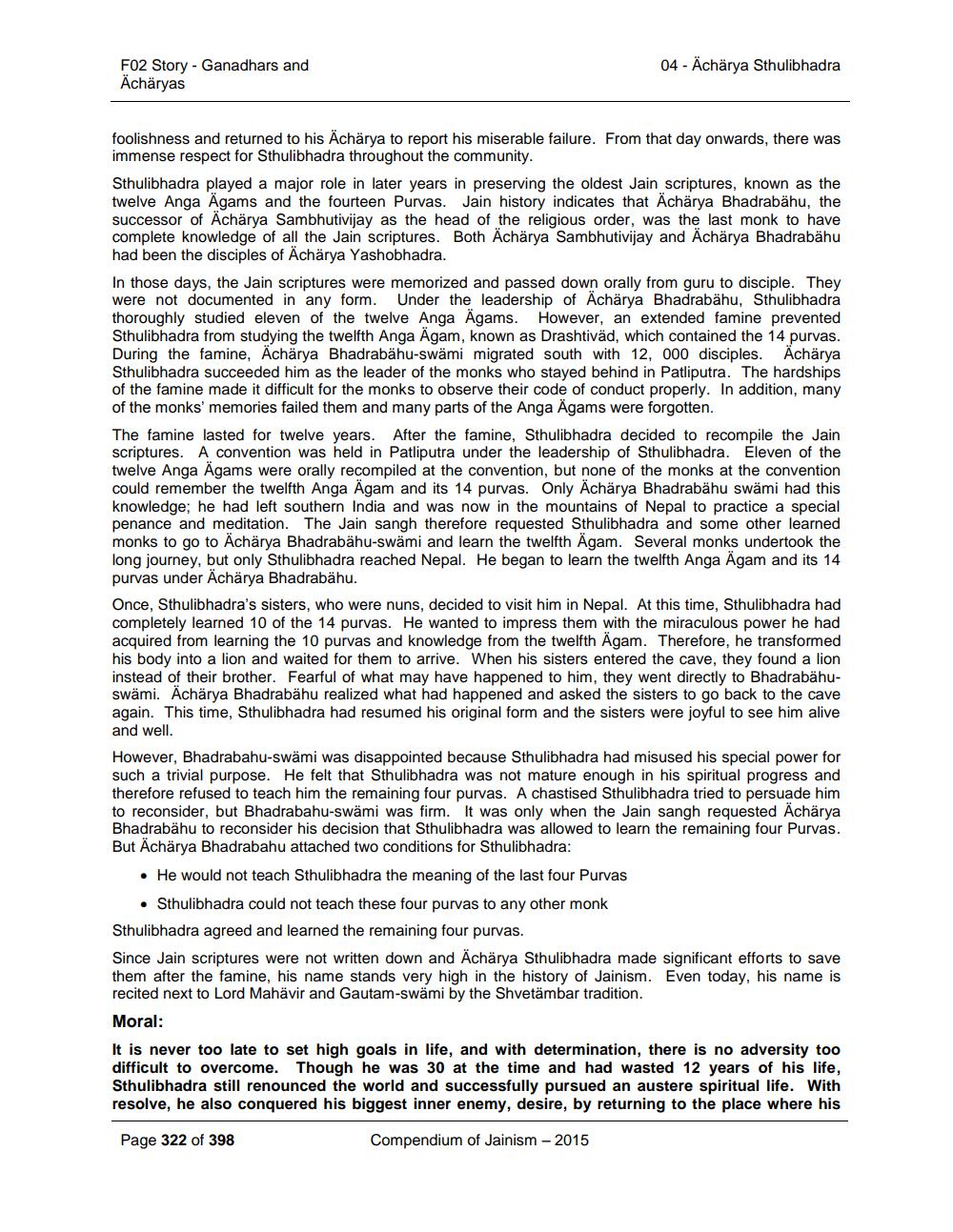________________
F02 Story - Ganadhars and Acharyas
04 - Ächärya Sthulibhadra
foolishness and returned to his Ächärya to report his miserable failure. From that day onwards, there was immense respect for Sthulibhadra throughout the community.
Sthulibhadra played a major role in later years in preserving the oldest Jain scriptures, known as the twelve Anga Ägams and the fourteen Purvas. Jain history indicates that Ächärya Bhadrabähu, the successor of Ächärya Sambhutivijay as the head of the religious order, was the last monk to have complete knowledge of all the Jain scriptures. Both Ächärya Sambhutivijay and Ächärya Bhadrabähu had been the disciples of Ächärya Yashobhadra.
In those days, the Jain scriptures were memorized and passed down orally from guru to disciple. They were not documented in any form. Under the leadership of Ächärya Bhadrabähu, Sthulibhadra thoroughly studied eleven of the twelve Anga Ägams. However, an extended famine prevented Sthulibhadra from studying the twelfth Anga Ägam, known as Drashtiväd, which contained the 14 purvas. During the famine, Ächärya Bhadrabähu-swämi migrated south with 12, 000 disciples. Ächärya Sthulibhadra succeeded him as the leader of the monks who stayed behind in Patliputra. The hardships of the famine made it difficult for the monks to observe their code of conduct properly. In addition, many of the monks' memories failed them and many parts of the Anga Ägams were forgotten.
The famine lasted for twelve years. After the famine, Sthulibhadra decided to recompile the Jain scriptures. A convention was held in Patliputra under the leadership of Sthulibhadra. Eleven of the twelve Anga Ägams were orally recompiled at the convention, but none of the monks at the convention could remember the twelfth Anga Ägam and its 14 purvas. Only Ächärya Bhadrabähu swämi had this knowledge; he had left southern India and was now in the mountains of Nepal to practice a special penance and meditation. The Jain sangh therefore requested Sthulibhadra and some other learned monks to go to Ächärya Bhadrabähu-swämi and learn the twelfth Ägam. Several monks undertook the long journey, but only Sthulibhadra reached Nepal. He began to learn the twelfth Anga Ägam and its 14 purvas under Ächärya Bhadrabähu.
Once, Sthulibhadra's sisters, who were nuns, decided to visit him in Nepal. At this time, Sthulibhadra had completely learned 10 of the 14 purvas. He wanted to impress them with the miraculous power he had acquired from learning the 10 purvas and knowledge from the twelfth Ägam. Therefore, he transformed his body into a lion and waited for them to arrive. When his sisters entered the cave, they found a lion instead of their brother. Fearful of what may have happened to him, they went directly to Bhadrabähuswämi. Ächärya Bhadrabähu realized what had happened and asked the sisters to go back to the cave again. This time, Sthulibhadra had resumed his original form and the sisters were joyful to see him alive and well.
However, Bhadrabahu-swämi was disappointed because Sthulibhadra had misused his special power for such a trivial purpose. He felt that Sthulibhadra was not mature enough in his spiritual progress and therefore refused to teach him the remaining four purvas. A chastised Sthulibhadra tried to persuade him to reconsider, but Bhadrabahu-swämi was firm. It was only when the Jain sangh requested Ächärya Bhadrabähu to reconsider his decision that Sthulibhadra was allowed to learn the remaining four Purvas. But Ächärya Bhadrabahu attached two conditions for Sthulibhadra:
• He would not teach Sthulibhadra the meaning of the last four Purvas • Sthulibhadra could not teach these four purvas to any other monk Sthulibhadra agreed and learned the remaining four purvas.
Since Jain scriptures were not written down and Ächärya Sthulibhadra made significant efforts to save them after the famine, his name stands very high in the history of Jainism. Even today, his name is recited next to Lord Mahävir and Gautam-swämi by the Shvetämbar tradition.
Moral:
It is never too late to set high goals in life, and with determination, there is no adversity too difficult to overcome. Though he was 30 at the time and had wasted 12 years of his life, Sthulibhadra still renounced the world and successfully pursued an austere spiritual life. With resolve, he also conquered his biggest inner enemy, desire, by returning to the place where his
Page 322 of 398
Compendium of Jainism - 2015




